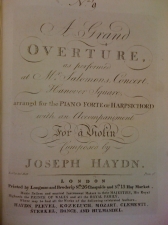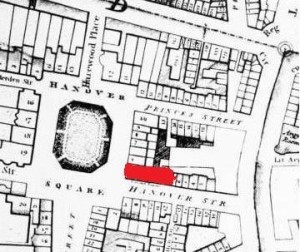To do justice to the Hanover Square Rooms in a single posting simply isn’t possible, so this will be the first of two postings.
The Hanover Square Rooms (known at first as the New Assembly Rooms) were built by Giovanni Gallini (1728 – 1895) – or Sir John Gallini as he styled himself – in the garden of No. 4 Hanover Square which he had purchased in 1773. The building contained a main room which held about 500 people with a platform for the performers at one end and a Royal Box opposite, all decorated in fashionable style (as a comparison, the space was somewhat smaller than the Wigmore Hall). For almost a century this was the London concert venue, and to be seen there, certainly in the early days when music was all the rage, was a must in fashionable society.
The first concert was given on 1st February 1775, organised by Johann Christian Bach and Carl Friedrich Abel, one of the most successful concert-promotion partnerships of the late eighteenth century. Performances were advertised in the Public Advertiser (Monday 30th January) and the Morning Chronicle (Saturday 28th January) thus:
“MESS. Bach and Abel take the Liberty to acquaint the Nobility and Gentry Subscribers to their CONCERTS that [details of the next concert] …. The Nobility and Gentry are most humbly desired to order their Coachmen to set them down …at the door in Hanover Street with their Horses Heads towards Grosvenor Square, the Door in the Square being for Ladies [Sedan] Chairs only.”
(Clearly traffic problems were as prevalent in 18th century London as they are today).

1791 arrangement of Haydn’s symphony no.92 in G major for pianoforte by Dussek. (UL classmark: Mus.3.72-74)
The Bach-Abel subscription series concerts continued until J. C. Bach’s death in 1782 and in 1785 they were succeeded by the Professional Concerts a subscription series organised by the players themselves and led by Wilhelm Cramer (pre-empting the LSO by some 120 years), which continued until 1793. They became very popular: the programmes were usually 10 – 12 items (typical for the time) presenting a mix of orchestral pieces, concerti, chamber music and vocal items concentrating for the most part on modern repertoire including works by Haydn, Pleyel and Abel.
Probably the best-known Hanover Square concerts of the time were the violinist Johann Peter Salomon’s subscription series in 1791, 1792 and 1794 at which many of Haydn’s “London” symphonies were given, directed from the harpsichord by the composer. The first series of twelve concerts began (after some delays) on 11 March 1791, and the “New Grand Overture” by Haydn, which began the second half, is most probably symphony no. 92 (H. C. Robbins-Landon reviews the evidence in v. 3 of his Haydn Chronicle and Works: Haydn in England pp. 54 – 55).
Concerts continued weekly thereafter for which Salomon charged a five guinea subscription (about £350 today). One can only hope that the “Nobility and Gentry” realised what a very special series they were to experience. Certainly the Morning Chronicle waxed lyrical with a report of the concert the following day: “…never was there a richer musical treat…Haydn should be an object of homage and even idolatry…His new Grand Overture [the new symphony] was pronounced … to be a most wonderful composition.” Further concert series followed in 1792 and 1794 to great acclaim.
So with the sound of Haydn’s Grand Overture “with the Militaire Movement” [no. 100 in G] ringing in our ears from the final 1794 Salomon concert on 12th May, we will take our leave of Hanover Square until the next time…
SW



Pingback: Bygone concert venues 3: Hanover Square Rooms (II) | MusiCB3 Blog
Pingback: Bygone concert venues 4: The Pantheon, Oxford Street | MusiCB3 Blog
Pingback: Bygone concert venues 6.1: Black Bear Inn. Mr. Incledon comes to Cambridge | MusiCB3 Blog
Very good post! I am linking to my blog, http://londondiaryblog.wordpress.com in which I am following Bradshaw’s Hand Book to London, 1862. Thank you
LikeLike
Pingback: Bradshaw’s Hand Book, The West, Sixth Day, Regent Street & surrounds, (no.31) | London Life with Bradshaw's Hand Book
Pingback: Bygone concert venues 7: St. James’s Hall | MusiCB3 Blog
Pingback: Beethoven 250: What’s in a name? The “Bridgetower” Sonata | MusiCB3 Blog